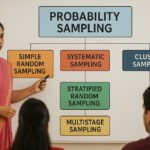Introduction
In any research journey—whether it’s in social sciences, healthcare, engineering, education, or business—the cornerstone of reliable findings lies in one crucial element: data. The way data is collected not only determines the validity and reliability of your results but also the credibility of your research outcomes.
In this blog post, we will explore the importance of data in research, understand the different data collection methods, and look at domain-specific examples that illustrate how each method is practically applied. This guide is especially useful for students, scholars, and professionals aiming to build a robust methodology for their academic or industry-based research projects.
Why is Data Collection Important in Research?
Data is the lifeblood of research. It forms the basis for analysis, interpretation, and theory-building. The way we collect data influences how accurately our findings reflect reality.
Key roles of data in research:
- Supports or rejects hypotheses
- Reveals patterns and trends
- Informs decision-making
- Strengthens credibility and replicability
From identifying customer preferences to diagnosing mental health challenges, data provides the foundation for evidence-based insights across disciplines.
Types of Data: Quantitative vs. Qualitative
Understanding data types helps determine the appropriate collection method.
| Type | Nature | Examples | Best Used In |
| Quantitative | Numerical | Age, salary, product ratings | Experiments, surveys |
| Qualitative | Descriptive | Interview responses, observations | Case studies, ethnography |
Researchers often blend both to strengthen validity—a strategy known as mixed methods research.
Primary vs. Secondary Data Collection
| Type | Source | Example |
| Primary Data | Collected firsthand for the study | Interviews, surveys, focus groups |
| Secondary Data | Pre-existing data collected by others | Census, published reports, academic databases |
Primary Data Collection Methods
1. Surveys and Questionnaires (Online and Printed)
Surveys help collect standardized data from a large population. These can be administered digitally or physically, depending on the context and respondent accessibility.
a. Online Surveys
Tools like Google Forms or SurveyMonkey allow researchers to collect data efficiently.
b. Physical (Printed) Questionnaires
In rural areas or offline environments, printed questionnaires are still a highly effective tool. Researchers distribute physical forms directly to respondents—often in paper-and-pencil format—and collect them after a set duration.
Practical Example (Social Science / Rural Studies):
A researcher conducting a study on women’s participation in self-help groups in rural Tamil Nadu may use printed questionnaires due to low internet penetration. Local language forms are distributed during community meetings.
Advantages:
- Suitable for populations without digital access
- Enables face-to-face rapport-building
- Useful for illiterate respondents with researcher assistance
Tips for Success:
- Use clear, simple language
- Pretest the form before large-scale distribution
- Include both closed and open-ended questions
2. Interviews
Interviews allow deeper probing into experiences, opinions, and motivations.
Example (Healthcare Research):
To understand emotional burnout among ICU nurses, a semi-structured interview format allows participants to narrate experiences in their own words.
Types:
- Structured: Fixed set of questions
- Semi-structured: Flexible questions with room for elaboration
- Unstructured: Open conversations guided by a research theme
3. Focus Groups
Group discussions with 6–10 participants to explore collective views on a topic.
Example (Consumer Research):
Before launching a new mobile phone, a company conducts focus groups with young adults to gather feedback on design and usability.
4. Observations
Researchers observe subjects in natural or controlled environments.
Example (Education Research):
To measure student engagement, a researcher may observe classroom behavior during different teaching methods (e.g., lectures vs. group projects).
Types:
- Naturalistic Observation
- Controlled Observation
- Participant Observation
5. Experiments
Used to examine cause-effect relationships in controlled settings.
Example (Psychology Research):
A lab experiment may test whether sleep deprivation affects memory recall among college students.
Secondary Data Collection
Secondary data includes statistics, records, and reports previously collected for other purposes.
| Domain | Source | Application |
| Public Health | NFHS, WHO | Trends in immunization coverage |
| Economics | RBI, World Bank, IMF | Exchange rate or inflation analysis |
| Education | NCERT, UDISE+ | Literacy rates, student-teacher ratio |
| Finance | NSE, SEBI, Annual Reports | Stock returns, dividend payout analysis |
Technology and Physical Tools in Data Collection
| Type | Tools | Used For |
| Online Tools | Google Forms, Typeform, Qualtrics | Large-scale surveys, rapid polling |
| Interview Aids | Zoom, MS Teams, Otter.ai (transcription) | Virtual interviews, recording conversations |
| Observation | Video/audio tools, field notes | Capturing behavioral data |
| Printed Tools | Paper questionnaires, feedback sheets | Rural fieldwork, controlled environments |
Choosing the Right Method
Use the table below to guide your selection:
| Factor | Recommended Method |
| Large population | Surveys (online or printed) |
| In-depth understanding | Interviews, focus groups |
| Real-time behaviors | Observation |
| Controlled testing | Experiments |
| Data already available | Secondary sources |
| Limited internet access | Printed questionnaires, face-to-face interviews |
Ethics in Data Collection
Ethical practices are critical, especially when data involves human participants.
Checklist:
- Informed consent
- Anonymity and confidentiality
- Voluntary participation
- Ethical clearance from IRB/ethics committee
- Safe data storage and disposal
Example (Field Study in Schools):
When collecting responses from school students, parental consent and school approval are mandatory, especially if minors are involved.
Real-World Applications: Cross-Domain Examples
| Domain | Study Topic | Method Used |
| Education | Online learning satisfaction among students | Surveys + focus groups |
| Business | Brand loyalty factors in Gen Z consumers | Questionnaires + in-store observation |
| Public Health | Malnutrition awareness in rural households | Printed surveys + interviews |
| Engineering | Usability of new mobile app interface | Experiments + screen recording observation |
| Sociology | Gender roles in rural leadership committees | Focus groups + field notes |
Conclusion
Whether you’re conducting research for academia, government, or industry, the success of your findings hinges on the method of data collection. Printed questionnaires still hold importance in offline communities, just as digital tools revolutionize modern surveys.
Final Takeaways:
- Choose the method based on your population and goals
- Balance between cost, depth, and reach
- Combine multiple methods for comprehensive insights
- Always uphold ethical standards
A well-planned data collection strategy ensures valid, reliable, and actionable research outcomes.
Need assistance, contact us!









Leave a Reply